lasernet
امید وارم که از بازدید خود رضایتمند باشیدlasernet
امید وارم که از بازدید خود رضایتمند باشیداستادیوم هایی جام جهانی ۲۰۰۶
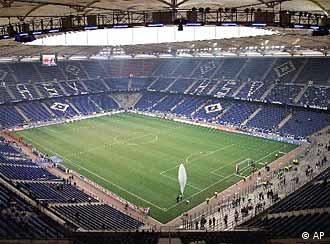 استادیوم هامبورگ
استادیوم هامبورگ
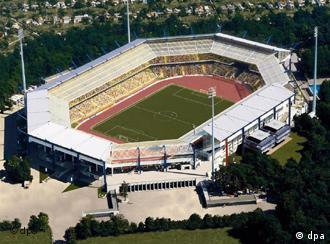 Nuremberg استادیوم
Nuremberg استادیوم
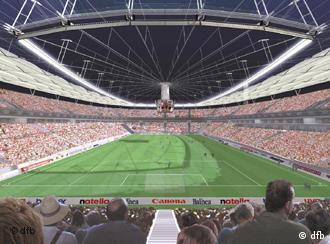 Frankfurt am Main استادیوم
Frankfurt am Main استادیوم
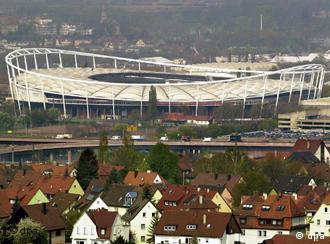 Stuttgart
Stuttgart
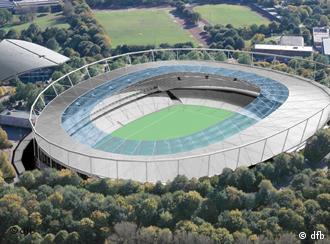 Bildunterschrift: June 12, 2006: Qualifying Group E: ITA – CHA / June 16, 2006: Qualifying Group D: MEX – ANG / June 20, 2006: Qualifying Group A: CRC – POL / June 23, 2006: Qualifying Group G: SUI – KOR / June 27, 2006: Quarter-Final
Bildunterschrift: June 12, 2006: Qualifying Group E: ITA – CHA / June 16, 2006: Qualifying Group D: MEX – ANG / June 20, 2006: Qualifying Group A: CRC – POL / June 23, 2006: Qualifying Group G: SUI – KOR / June 27, 2006: Quarter-Final
Hanover is another German city that gets its fair share of bad press. "Boring, boring Hanover" could be the refrain…But, like so many others, it doesn't deserve its bad reputation. The capital of Lower Saxony is a beautiful city which has benefited from the 2000 Expo exhibition and the fact that former German chancellor chooses to call it home. Herr Schröder shares the city with half a million other inhabitants, all of whom take great pride in the fact that its dialect is considered to be the purest form of German. That aside, the soccer team has gone through an image change. A regular in the lower leagues from some time, Hannover 96 now regularly appear in the top flight between the odd relegation seasons. The huge old stadium, dubbed FIFA World Cup Stadium Hanover for the 2006 tournament, used to echo to the sound a disgruntled few in the bad old days but now the recently renovated 45,000 capacity jewel entertains burgeoning crowds on match days, and will do so during the five World Cup matches it hosts.
Berlin
 Bildunterschrift: June 13, 2006: Qualifying Group F: BRA – CRO / June 15, 2006: Qualifying Group B: SWE – PAR / June 20, 2006: Qualifying Group A: ECU – GER / June 23, 2006: Qualifying Group H: UKR – TUN / June 30, 2006: Quarter-Final July 9, 2006: Final
Bildunterschrift: June 13, 2006: Qualifying Group F: BRA – CRO / June 15, 2006: Qualifying Group B: SWE – PAR / June 20, 2006: Qualifying Group A: ECU – GER / June 23, 2006: Qualifying Group H: UKR – TUN / June 30, 2006: Quarter-Final July 9, 2006: Final
What can be said about Berlin that hasn't been said before? A war-time capital under the Third Reich's heel, then a microcosm of a divided land split by a wall on the front line of the East-West divide, Berlin has seen it all, lived it all and been it all. It is fitting then, as its regeneration and re-emergence continues that the World Cup final be played in Berlin.
For a World Cup capital, Berlin can provide some of the most poignant and spectacular backdrops for celebrating fans and the party atmosphere of the global soccer carnival. But there will always be a shadow over the city. Even the extensive rebuilding of Berlin's Olympiastadion cannot fully erase the legacy of the Nazi's Olympic Games almost 70 years ago. But the songs of a multitude of international supporters, the colors of a host of nations and the magic all hope to see on the pitch will go a long way in replacing less favorable memories with more positive ones.
Dortmund
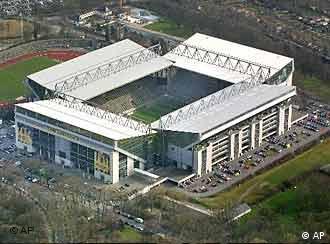 Bildunterschrift: June 10, 2006: Qualifying Group B: TRI – SWE / June 14, 2006: Qualifying Group A: GER – POL / June 19, 2006: Qualifying Group G: TOG – SUI / June 22, 2006: Qualifying Group F: JPN – BRA / June 27, 2006: Quarter-Final July 4, 2006: Semi-Final
Bildunterschrift: June 10, 2006: Qualifying Group B: TRI – SWE / June 14, 2006: Qualifying Group A: GER – POL / June 19, 2006: Qualifying Group G: TOG – SUI / June 22, 2006: Qualifying Group F: JPN – BRA / June 27, 2006: Quarter-Final July 4, 2006: Semi-Final
Once one of Germany's most powerful soccer cities, Dortmund's brewery and steel achievements have long been eclipsed by the three championships and European Cup success of Borussia Dortmund's soccer past. But the BVB have had little to cheer about in more recent years as the club's lack of sporting success has been matched in terms of financial failure. Still, the fanatical support of the Dortmund faithful have kept the team alive with regular 80,000 sell-out crowds in one of Germany's biggest stadiums.
The Westfalenstadion has an international reputation as a pure cauldron of fervent support and atmosphere. With the massive southern stands terracing the stadium, the Dortmund crowd's decibel levels put other fan blocks to shame. Even when the World Cup comes to Dortmund, with FIFA banning standing areas from host venues, the reduced 69,000 capacity will produce a cacophony of noise.
Kaiserslautern
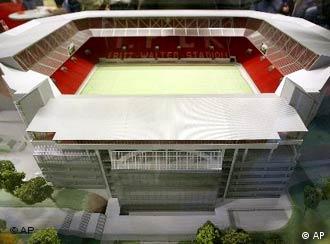 Bildunterschrift: June 12, 2006: Qualifying Group F: AUS – JPN / June 17, 2006: Qualifying Group E: ITA – USA / June 20, 2006: Qualifying Group B: PAR – TRI / June 23, 2006: Qualifying Group H: KSA – ESP / June 26, 2006: Quarter-Final
Bildunterschrift: June 12, 2006: Qualifying Group F: AUS – JPN / June 17, 2006: Qualifying Group E: ITA – USA / June 20, 2006: Qualifying Group B: PAR – TRI / June 23, 2006: Qualifying Group H: KSA – ESP / June 26, 2006: Quarter-Final
So, where exactly is Kaiserslautern again? One without a passion for German soccer would have to be very interested in Germany to know that the 100,000 inhabitant town lies in the Pfälzer Wald forest. But in terms of soccer lore, Kaiserslautern is a famous town in Germany and Europe. Four players of West Germany's famous world champion side of 1954 came from the local 1. Kaiserslautern FC, under the tutelage of the legendary Fritz Walter, who Fritz-Walter-Stadion is named after.
In the years that followed that feat, Lautern had some memorable European nights and also gained cult status as a club that had only ever been out of the top flight once in its history -- coming back from its single regulation to win the Bundesliga the following year, an achievement that has yet to be matched. The team even has a huge following in the United States -- mainly due to the US military base stationed on the town's outskirts.
Most towns have a stadium, but in Kaiserslautern, the stadium has a town. Towering over the town atop the Betzenberg mountain, Fritz-Walter-Stadion has only recently got off the long path of renovations and expansion it needed to travel before reaching its current World Cup capacity of 48,500. Its English design offers the intimacy through narrow stands and close proximity to the pitch, giving those visiting the Red Devils' home of a great view of the five World Cup matches taking place there.
Munich
 Bildunterschrift: June 9, 2006: Qualifying Group A: GER – CRC (Opening game) / June 14, 2006: Qualifying Group H: TUN – KSA / June 18, 2006: Qualifying Group F: BRA – AUS / June 21, 2006: Qualifying Group C: CIV – SCG / June 24, 2006: Quarter-Final / July 5, 2006: Semi-Final
Bildunterschrift: June 9, 2006: Qualifying Group A: GER – CRC (Opening game) / June 14, 2006: Qualifying Group H: TUN – KSA / June 18, 2006: Qualifying Group F: BRA – AUS / June 21, 2006: Qualifying Group C: CIV – SCG / June 24, 2006: Quarter-Final / July 5, 2006: Semi-Final
The Bavarian capital has seen more than its fair share of global sports events, but for German soccer fans, Munich is remembered for the 1974 World Cup final when West Germany beat Holland 2-1 to score the title on home turf. While the stadium that hosted that monumental night in German soccer history has been replaced by a new stadium, the self-styled "cosmopolitan capital" of Germany still has a traditional soccer heart beneath the glamour. Construction on the 66,000 capacity Allianz Arena, renamed FIFA World Cup Stadium Munich for the summer's tournament, finished in time for the 2005/06 Bundesliga season turning what used to be a garbage dump into a home base for the city's two league sides Bayern Munich and 1860 Munich. Still, it is the World Cup crowds who will created the biggest cacophony of sound behind the stadium's semi-transparent walls when Germany faces Costa Rica in the 2006 World Cup's initial game.
Cologne
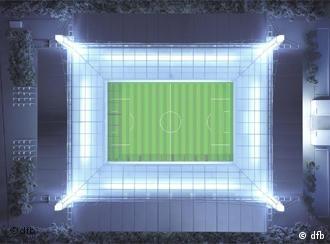 Bildunterschrift: June 11, 2006: Qualifying Group D: ANG – POR / June 17, 2006: Qualifying Group E: CZE – GHA / June 20, 2006: Qualifying Group B: SWE – ENG / June 23, 2006: Qualifying Group G: TOG – FRA / June 26, 2006: Quarter-Final
Bildunterschrift: June 11, 2006: Qualifying Group D: ANG – POR / June 17, 2006: Qualifying Group E: CZE – GHA / June 20, 2006: Qualifying Group B: SWE – ENG / June 23, 2006: Qualifying Group G: TOG – FRA / June 26, 2006: Quarter-Final
Cologne is synonymous with its cathedral and the raucous annual carnival celebration. While one is an architectural source of national and international pride, the other is practically a way of life, and soccer is an all consuming passion in the city on the Rhine. Despite the fluid nature of the home team's fortunes, locals follow 1.FC Köln with an almost religious fervor. It is this dedication that convinced the club to invest heavily in the new stadium, and the results were enough to secure Cologne a place among Germany's World Cup host cities.
The last time the World Cup came to Cologne was in 1974, and the stadium built for that event was perceived by all as a gaping and draughty concrete bowl, so there was hardly a tear shed when the demolition teams moved in. Now a compact cauldron of passion sits in its place, capable of holding 45,000 baying fans in an intimate and intimidating atmosphere, the FIFA World Cup Stadium Cologne is an arena worthy of the summer's soccer spectacle.
Gelsenkirchen
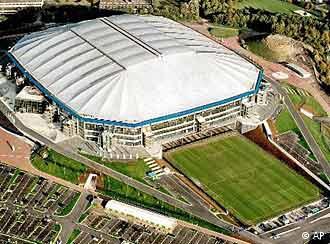 Bildunterschrift: June 9, 2006: Qualifying Group A: POL – ECU / June 12, 2006: Qualifying Group E: USA – CZE / June 16, 2006: Qualifying Group C: ARG – SCG / June 21, 2006: Qualifying Group D: POR – MEX / July 1, 2006: Quarter-Final
Bildunterschrift: June 9, 2006: Qualifying Group A: POL – ECU / June 12, 2006: Qualifying Group E: USA – CZE / June 16, 2006: Qualifying Group C: ARG – SCG / June 21, 2006: Qualifying Group D: POR – MEX / July 1, 2006: Quarter-Final
Few German towns have such a bad rap as Gelsenkirchen. However, the attraction of tourism is not one of Gelsenkirchen's main goals and has never been. A mining town in the west of the Ruhr region, Gelsenkirchen has always been a rough and ready place, But the city has one thing that eclipses all others for the locals: Schalke 04.
The Arena Auf Schalke, home of the Royal Blues and renamed FIFA World Cup Stadium Gelsenkirchen for the summer's tournament, is one of the jewels of Germany's soccer stadiums. Completed in 2003, the stadium is equipped with a sliding roof, a pitch that can be moved outside the stadium to air and even its own chapel where divine assistance is often called upon. The real death knell for opposing teams comes when it is packed with 52,000 fans. A stadium capable of incredible noise and atmosphere, a seat in Gelsenkirchen's stands has the ability to turn any game into sporting event to remember.
Leipzig
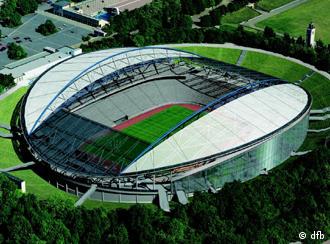 Bildunterschrift: June 11, 2006: Qualifying Group C: SCG – NED / June 14, 2006: Qualifying Group H: ESP – UKR / June 18, 2006: Qualifying Group G: FRA – KOR / June 21, 2006: Qualifying Group D: IRN – ANG / June 24, 2006: Quarter-Final
Bildunterschrift: June 11, 2006: Qualifying Group C: SCG – NED / June 14, 2006: Qualifying Group H: ESP – UKR / June 18, 2006: Qualifying Group G: FRA – KOR / June 21, 2006: Qualifying Group D: IRN – ANG / June 24, 2006: Quarter-Final
With the city's Olympic bid withering in the company of competitors such as New York, Paris and London, it was a god-send for Leipzig to be named as one of the World Cup venues. Oft lamented as a poor eastern relation to many more glamorous cities, visitors to Leipzig are in for a pleasant surprise.. Situated on the banks of the Auer River, Leipzig survived the devastation of World War II and the mass exodus of inhabitants to the west after the fall of the Berlin Wall, leaving a rich cultural history intact.
It was also a formidable force in sports during the days of the former East Germany. Lokomotiv Leipzig was a much a driving force as their name implied and one that was taken seriously throughout Europe. But those days are long gone, and Leipzig will entertain World Cup fans as the only location without a first, second or even third division club playing in Zentralstadion. However, the new stadium is an ultramodern arena worthy of the tournament, even if it may struggle to fill its seats once the World Cup is over.
" رابرت ساها " و " آلونگ آلونگ " دوبازیکن خارجی تیم فوتبال پرسپولیس امشب (پنجشنبه) ایران را ترک میکنند.
به گزارش سایت رسمی باشگاه پرسپولیس، رابرت ساها مدافع اهل چک تیم فوتبال پرسپولیس امشب با پرواز هواپیمائی لوفت هانزا فرودگاه مهرآباد را به مقصد مونیخ آلمان ترک میکند و بعد از دقایقی توقف در فرودگاه مونیخ راهی وین اتریش میشود .
آلونگ آلونگ هافبک میانی تیم فوتبال پرسپولیس هم امشب با پرواز ایرفرانس فرودگاه مهرآباد را به مقصد پاریس فرانسه ترک میکند و بعد هم راهی شهر دوآلا کامرون میشود.
ساها و آلونگ روز یازدهم تیرماه به تهران برمی گردند تا در دور جدید تمرینات تیم فوتبال پرسپولیس شرکت کنند.
" رافائل ادرهو " مهاجم نیجریهای تیم فوتبال پرسپولیس نیز قرار است فردا ایران را ترک کند.
ادرهو که قبلا در یک تیم فنلاندی بازی میکرد، روز جمعه با پرواز هواپیمائی لوفت هانزا تهران را به مقصد فرانکفورت ترک میکند و بعد از چند ساعت توقف راهی هلسینکی فنلاند میشود.
راهنمای تیمهای شرکت کننده در جام جهانی آلمان
|
از میان 194 کشور عضو فیفا که برای راهیابی به جام جهانی آلمان 2006 در مرحله انتخابی حضور داشتند، 32 تیم موفق شدند مجوز ورود به این بازیها را بدست آوردند.
14 تیم از اروپا، 4 تیم از آمریکای جنوبی، 4 تیم از منطقه کونکاکاف و آمریکای مرکزی، 4 تیم از آسیا، 5 تیم از آفریقا و یک تیم از اقیانوسیه تیم های حاضر در این تورنمنت را تشکیل می دهند. مطالب زیر خلاصه ای از مشخصات کلی تیمهای حاضر در این بازیها گروه A
گروه B
گروه C
گروه D
گروه E
گروه F
گروه G
گروه H
|